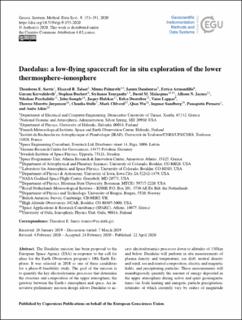| dc.contributor.author | Sarris, Theodoros E. | |
| dc.contributor.author | Talaat, Elsayed R. | |
| dc.contributor.author | Palmroth, Minna | |
| dc.contributor.author | Dandouras, Iannis | |
| dc.contributor.author | Armandillo, Errico | |
| dc.contributor.author | Kervalishvili, Guram | |
| dc.contributor.author | Buchert, S. C. | |
| dc.contributor.author | Tourgaidis, Stylianos | |
| dc.contributor.author | Malaspina, David | |
| dc.contributor.author | Jaynes, Allison N. | |
| dc.contributor.author | Paschalidis, Nikolaos | |
| dc.contributor.author | Sample, John | |
| dc.contributor.author | Halekas, Jasper | |
| dc.contributor.author | Doornbos, Eelco | |
| dc.contributor.author | Lappas, Vaios | |
| dc.contributor.author | Moretto, Therese | |
| dc.contributor.author | Stolle, Claudia | |
| dc.contributor.author | Clilverd, Mark | |
| dc.contributor.author | Wu, Qian | |
| dc.contributor.author | Sandberg, Ingmar | |
| dc.contributor.author | Pirnaris, Panagiotis | |
| dc.contributor.author | Aikio, Anita | |
| dc.date.accessioned | 2021-08-03T08:25:53Z | |
| dc.date.available | 2021-08-03T08:25:53Z | |
| dc.date.created | 2021-02-15T13:36:57Z | |
| dc.date.issued | 2020 | |
| dc.identifier.issn | 2193-0856 | |
| dc.identifier.uri | https://hdl.handle.net/11250/2765946 | |
| dc.description.abstract | The Daedalus mission has been proposed to the European Space Agency (ESA) in response to the call for ideas for the Earth Observation program's 10th Earth Explorer. It was selected in 2018 as one of three candidates for a phase-0 feasibility study. The goal of the mission is to quantify the key electrodynamic processes that determine the structure and composition of the upper atmosphere, the gateway between the Earth's atmosphere and space. An innovative preliminary mission design allows Daedalus to access electrodynamics processes down to altitudes of 150 km and below. Daedalus will perform in situ measurements of plasma density and temperature, ion drift, neutral density and wind, ion and neutral composition, electric and magnetic fields, and precipitating particles. These measurements will unambiguously quantify the amount of energy deposited in the upper atmosphere during active and quiet geomagnetic times via Joule heating and energetic particle precipitation, estimates of which currently vary by orders of magnitude between models and observation methods. An innovation of the Daedalus preliminary mission concept is that it includes the release of subsatellites at low altitudes: combined with the main spacecraft, these subsatellites will provide multipoint measurements throughout the lower thermosphere–ionosphere (LTI) region, down to altitudes below 120 km, in the heart of the most under-explored region in the Earth's atmosphere. This paper describes Daedalus as originally proposed to the ESA. | en_US |
| dc.language.iso | eng | en_US |
| dc.publisher | Copernicus Publications | en_US |
| dc.rights | Navngivelse 4.0 Internasjonal | * |
| dc.rights.uri | http://creativecommons.org/licenses/by/4.0/deed.no | * |
| dc.title | Daedalus: A low-flying spacecraft for in situ exploration of the lower thermosphere-ionosphere | en_US |
| dc.type | Journal article | en_US |
| dc.type | Peer reviewed | en_US |
| dc.description.version | publishedVersion | en_US |
| dc.rights.holder | Copyright 2020 The Author(s) | en_US |
| cristin.ispublished | true | |
| cristin.fulltext | original | |
| cristin.qualitycode | 1 | |
| dc.identifier.doi | 10.5194/gi-9-153-2020 | |
| dc.identifier.cristin | 1889917 | |
| dc.source.journal | Geoscientific Instrumentation, Methods and Data Systems | en_US |
| dc.source.pagenumber | 153-191 | en_US |
| dc.identifier.citation | Geoscientific Instrumentation, Methods and Data Systems. 2020, 9 (1), 153-191. | en_US |
| dc.source.volume | 9 | en_US |
| dc.source.issue | 1 | en_US |

